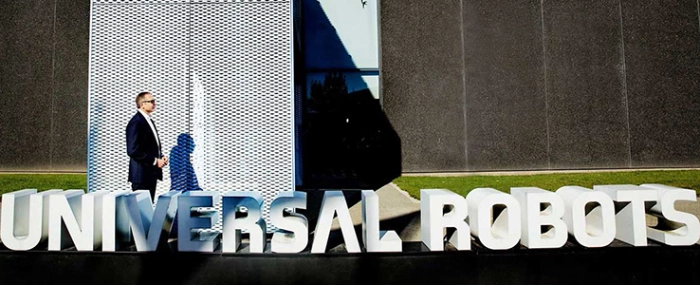
© Universal Robots
Business |
Specialisation kept Universal Robots agile through the years
Universal Robots, the Danish robotics company that many analysts credit with both creating and taking over the collaborative robot space.
In many ways we can attribute the shear amount of cobots in use throughout the world to Universal Robots. While UR might not have actually introduced cobots to the market, the company found the right recipe for making them not only an economically viable solution, but also a flexible one.
In contrast to the larger, heavier and more static industrial robots that one might think of when talking about robotic arms – those supplied by the likes of ABB, KUKA, and Yaskawa – Universal Robots have stayed with one specific constant; be nimble. The company’s biggest and heaviest robot arm – which can handle a payload of 16kg – weighs only 33kg. If we look at an industrial equivalent in terms of payload management, the robot itself weighs closer to 380 kg. Clearly, the company has been able to offer an automation solution that is more manageable for companies both in terms of usability and footprint. Something that is also visible in the market share that UR is holding.
Evertiq had the opportunity to chat with Jürgen von Hollen, president of Universal Robots, about how a seemingly small Danish startup has managed to not only create and dominate a new market, but is expanding in it too.
One of the recurring themes in our conversation is the fact that – despite the company being almost 14 years old and having had its products out on the market for many years – it still moves and navigates the market with the agility of startup.
“I believe this is one of the reasons to why we are in the position we are, that and our focus. Just the simple fact that we focus on what we’re good at, which is the robotic arm, and don’t venture out doing multiple things. Companies have wanted us to customise the arm throughout the years, but we have contentiously said no, and in the last 14 years, we haven’t really changed the product from its original form at all.”
What UR did do however, was to allow others to build upon their solution. They knew the limit to their in-house expertise and, like Mr. von Hollen explains, realised that introducing their own add-ons to the arm would require a different business set up. Furthermore, it would pull away resources from their focus area.
“We took a decision to focus on the robot arm. We’re not going to do anything else, the arm is what we do. Staying on top of just something like the hardware, that alone is tough but that’s what we do.”
That being said, you can still listen to market demands and address those in your own way. So, instead of being the automation solutions supplier that will develop and produce everything, UR continues to focus on its arm. The rest is left to other companies; experts in their respective fields.
“This is a far more powerful model than having one single company controlling everything. Now you have companies that have solutions based on our arm, adding a camera, gripper and whatever you want, and we not only allow this but also encourage it.”
Back in 2017, Universal Robots was basically a company that “had invented one invention”, as Mr von Hollen explains. What followed was a transformation into a process enabling company – and now – (with feedback from its customers) – an applications management company via its open ecosystem.
The business model of having an open ecosystem where anyone can participate in building upon UR’s robotic arms has allowed the Danish company to stay nimble and agile. Today, the company has more than 400 different developers working within the ecosystem.
But what makes Universal Robots arm a successful cobot? The arm itself needs to tick several boxes: it needs to be lightweight, reliable, cost-efficient, provide longevity and – most of all – needs to be easy to use. If the programming becomes too complex, it’s appeal as a cobot is lost.
So, the secret of success for UR is specialisation rather than being a “jack of all trades”. 37'000 sold cobots worldwide (report from ABI Research) has placed UR comfortably in the lead, ahead of Taiwanese provider Techman and Korea-based Doosan with 10'000 and 2'000 units sold respectively.
“This is the reason why we are here. Not the numbers themselves, but the fact that we’re bringing people back into production with our robot arm. When you look at it, many other automation solutions have brought along the very opposite. But with the products that we supply, companies can keep production and bring it back as we don’t replace people, we empower them with the aid of a robotic arm,” says Mr. von Hollen.

